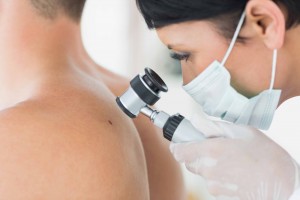Do you have moles? When was the last time you had them checked? Proper screening of moles (and actually, all skin in general) can help you to catch any signs of skin cancer early on while it is still curable. Here’s what you need to know about moles.
What Is a Mole?
A mole occurs when a type of cell known as a melanocyte  grows in a clump (instead of being spread evenly throughout the skin). Melanocytes produce the skin’s pigment. Think of a mole as a cluster of pigmented cells. Moles can be present at birth (congenital nevi) or can develop during childhood or adolescence. New moles as an adult are not common (and need to be evaluated by a doctor). Most adults have at least a few moles and some have many more.
grows in a clump (instead of being spread evenly throughout the skin). Melanocytes produce the skin’s pigment. Think of a mole as a cluster of pigmented cells. Moles can be present at birth (congenital nevi) or can develop during childhood or adolescence. New moles as an adult are not common (and need to be evaluated by a doctor). Most adults have at least a few moles and some have many more.
Moles and Skin Cancer… What’s the Link?
Moles and melanoma skin cancer are linked through melanocytes. Moles are made up of this type of cell and melanoma is a type of cancer that originates in this cell type. Most moles are harmless and will never develop melanoma, but changes in a mole can be an early sign of this type of cancer. Melanoma doesn’t just develop in or around moles. It can also appear on any area of the skin, and even in other areas of the body like the eyes.
Home Checks for Moles
One of the best ways to protect yourself is to become familiar with your skin. Perform regular at-home checks to look for changes and problem moles. Melanomas can vary greatly in their appearance, but many share a few common features. As you examine your skin, look for the ABCDEs.
- Asymmetry: Moles should be symmetrical (both sides the same). If your mole is uneven in its appearance, get it evaluated by a doctor.
- Border: Look for irregularity in the borders of your moles. Ragged edges or blurred outlines need medical evaluation.
- Color: Moles can be many colors (brown, black, red and even blue), but they should be a consistent color. If you see uneven coloration, see your doctor.
- Diameter: If your mole changes size, visit your doctor. Melanomas often increase in size. They are also typically large (greater than 6 mm), although some are tiny.
- Evolving: Changes in moles as an adult need further examination. See your doctor if you notice any changes, including the development of a new mole.
You can also reduce your risk of melanoma by using good sun practices. Wear a good quality sunscreen and protect your skin when you’ll be outdoors.
When Do I Need to See a Doctor?
See your doctor if you notice anything suspicious or any changes on your skin during your home checks. A yearly skin check by a dermatologist is also a good idea. Call us today at 310-829-9396 to book your appointment at the Santa Monica Laser and Skin Care Center.



